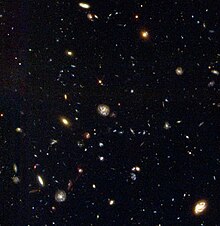Hubble Deep Field South
The Hubble Deep Field South ( HDF-S ) is a compilation of a few hundred images captured by the Hubble Space Telescope's Wide Field and Planetary Camera 2 (WFPC2) over a period of 10 days in September and October 1998. Like the original Hubble Deep Field , it was created to study extremely distant galaxies in the early stages of their evolution . While the WFPC2 recorded very deep optical images, adjacent regions were recorded simultaneously by the Space Telescope Imaging Spectrograph (STIS) and the Near Infrared Camera and Multiobject Spectrometer (NICMOS).
planning
One goal behind another deep field image was to give observatories in the southern hemisphere a similarly deep optical image as was made in the northern hemisphere . Just like in the original Hubble Deep Field (from then on named HDF-N), the target area is outside the galactic plane of the Milky Way , as this would have impaired the image with a lot of darkening matter and bright foreground stars. It is located in the space telescope's continuous viewing zone (CVZ), which is not affected by the earth and moon . The decision was made for an area in the constellation Toucan with the right ascension 22 h 32 m 56 s , 22 and declination −60 ° 33 '2 ", 69
This area was briefly mentioned back in 1997 in order to establish leadership stars. These are necessary so that the Hubble Space Telescope can precisely fix the region during the observation.
observation
The HDF-S was observed in the same way as the HDF-N. The same optical filters were used for the WFPC2 (centered around the wavelengths 300, 450, 606 and 814 nanometers ) and the observation period was also similarly long. Just like the HDF-N, the images were processed using a technique called 'drizzling', in which the telescope changes direction by a very small angle between observations. The image was then put together using complex techniques and a higher resolution achieved than would have been possible with just one picture. The HDF-S has a resolution of 0.0398 arc seconds .
Content of the finished image
According to the cosmological principle , the universe is homogeneous and isotropic at great distances , so it looks the same in all directions. Accordingly, the HDF-S was expected to be very similar to the HDF-N, and indeed it is. You can see a large number of visible galaxies that have similar colors and shapes to those in the HDF-N.
One difference was that the HDF-S contains a known quasar with a redshift of 2.24. They wanted to observe this in order to study galaxies and quasars at a similar distance from Earth at the same time.
Results
Like the HDF-N, the HDF-S provided cosmologists with a lot of material. Many studies of the HDF-S have confirmed the similarities with the HDF-N, such as the star formation rate in the course of the evolution of the universe. The HDF-S has also been used for many studies examining how galaxies evolve, both through their internal process and through encounters with other galaxies.
